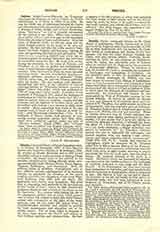

Ceadda, Saint, commonly known as St. Chad, Abbot of Lastingham, Bishop successively of York and Lichfield, England, date of birth uncertain; d. 672. He is often confounded with his brother, St. Cedd, also Abbot of Lastingham, and Bishop of the East Saxons. He had two other brothers, Cynibill and Caelin, who also became priests. Probably Northumbrian by birth, he was educated at Lindisfarne under St. Aldan, but afterwards went to Ireland, where he studied with St. Ecgberht in the monastery of Rathmelsige (Melfont). Thence he returned to help his brother St. Cedd to establish the monastery of Lestingmu, now Lastingham in Yorkshire: On his brother’s death in 664, he succeeded him as abbot. Shortly afterwards St. Wilfrid, who had been chosen to succeed Tudi, Bishop of Lindisfarne, went to Gaul for consecration, and remained so long absent that King Oswiu determined to wait no longer, and procured the election of Chad as Bishop of York, to which place the Bishopric of Lindisfarne had been transferred. As Canterbury was vacant, he was consecrated by Wini of Worcester, assisted by two British bishops. As bishop he visited his diocese on foot, and labored in an apostolic spirit until the arrival of St. Theodore, the newly elected Archbishop of Canterbury, who was making a general visitation. St. Theodore decided that St. Chad must give up the diocese to St. Wilfrid, who had now returned. When he further intimated that St. Chad’s episcopal consecration had not been rightly performed, the Saint replied, “If you decide that I have not rightly received the episcopal character, I willingly lay down the office; for I have never thought myself worthy of it; but under obedience, I, though unworthy, consented to undertake it”. St. Theodore, however, desired him not to relinquish the episcopate, and himself supplied what was lacking (“ipse ordinationem ejus denuo catholica ration consummavit” (Bede, Hist. eccl., IV, 2). Ceadda then returned to Lastingham, where he remained till St. Theodore called him in 669 to become Bishop of the Mercians. He built a church and monastery at Lichfield, where he dwelt with seven or eight monks, devoting to prayer and study the time he could spare from his work as bishop. He received warning of his death in a vision. His shrine, which was honored by miracles, was removed in the twelfth century to the cathedral at Lichfield, dedicated to Our Lady and the Saint himself. At the Reformation his relics were rescued from profanation by Catholics, and they now lie in the Catholic cathedral at Birmingham, which is dedicated to him. His festival is kept on the 2nd of March. All accounts of his life are based on that given by Venerable Bede, who had been instructed in holy Scripture by Trumberct, one of St. Chad’s monks and disciples.
EDWIN BURTON

